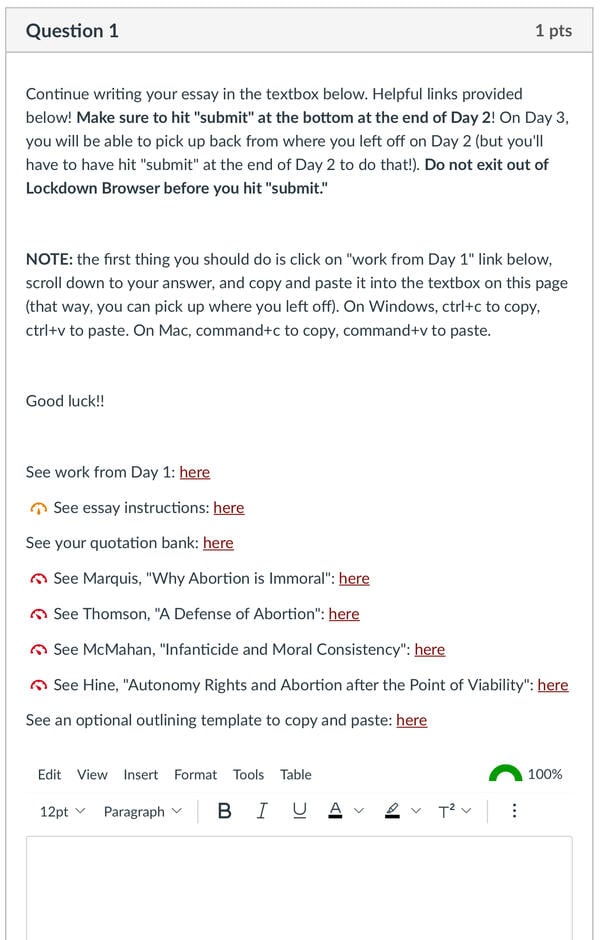You have /5 articles left.
Sign up for a free account or log in.

gorodenkoff/iStock/Getty Images Plus
A successful humanities course helps students cultivate critical, personally enriching and widely applicable skills, and it immerses them in the exploration of perspectives, ideas and modes of thought that can illuminate, challenge and inform their own outlooks.
Historically, the out-of-class essay assignment has been among the best assessments for getting students in humanities courses to most fully exercise and develop the relevant critical thinking skills. Through the writing process, students can come to better understand a problem. Things that seem obvious or obviously false before spending multiple days thinking and writing suddenly become no longer obvious or obviously false. Students make up their minds on complex problems by grappling with those problems in a rigorous way through writing and editing over a sustained period (i.e., not just writing in a blue book in one class session).
Unfortunately, since ChatGPT became widely available, out-of-class writing assignments keep becoming harder to justify as major assessments in introductory-level humanities courses. The intense personal engagement with perspectives and cultural artifacts central to the value of the humanities is more or less bypassed when a student heavily outsources to AI the generation and expression of ideas and analysis. As ChatGPT’s ability to write convincing papers goes up, so does the student temptation to rely on it (and so too does the difficulty for professors of reliably detecting AI).
Having experimented very extensively with ChatGPT, I have found that, at least when it comes to introductory-level philosophy courses, the material that ChatGPT can produce with 10 minutes of uninformed prompting rivals much of what we can reasonably expect students to produce on their own, especially given that one can upload readings/course materials and ask ChatGPT to adjust its voice (the reader should try this).
And students are relying on it a lot. Based on my time-consuming-and-quickly-becoming-obsolete detection techniques, about one in six of my students last fall were relying on ChatGPT in ways that were obvious. Given that it should take a student no more than 10 extra minutes on ChatGPT to make the case no longer obvious, I have to conclude that the real number of essays relying on ChatGPT in ways that conflict with academic integrity must be at least around 30 percent.
It is unclear whether AI-detection software is sufficiently reliable to justify its use (I haven’t used it), and—at any rate—many universities prohibit reliance on it. Some instructors believe that making students submit their work as a Google Doc with track-changes history is an adequate deterrent and detection tool for AI. It is not. Students are aware of their track-changes history—they know they simply have to type ChatGPT content instead of copying and pasting it. Actually, students don’t even have to type the AI-generated content: There are readily available Google Chrome extensions that take text and “type” it at manipulable speeds (with pauses, etc.). Students can copy/paste a ChatGPT essay and have the extension “type” it into a Google Doc at a humanlike pace.
Against this backdrop, I spent lots of time over the last winter break familiarizing myself with Lockdown Browser (a tool integrated with learning management software like Canvas that prevents access to and copying/pasting from programs outside of the LMS) and devising a new assignment model that I happily used this past semester.
It is a multiday in-class writing assignment, where students have access through Lockdown Browser to (and only to): PDFs of the readings, a personal quotation bank they previously uploaded, an outlining document and the essay instructions (which students were given at least a week before so they had time to begin thinking through their topic).
On Day 1 in class, students enter a Canvas essay-question quiz through Lockdown Browser with links to the resources mentioned above (each of which opens in a new tab that students can access while writing). They spend the class period outlining/writing and hit “submit” at the end of the session.
Between the Day 1 and Day 2 writing sessions, students can read their writing on Canvas (so they can continue thinking about the topic) but are prevented from being able to edit it. If you’re worried about students relying on ChatGPT for ideas to try to memorize/regurgitate (I don’t know how worried we should be about students inevitably trying this), consider introducing small wrinkles to the essay instructions during the in-class sessions (e.g. “your essay must somewhere critically discuss this example”).
On Day 2, students come to class and can pick back up right from where they left off.
A Day 2 session looks like this:

Courtesy of John Robison
One can potentially repeat the process for a third session. I had my 75-minute classes take two days and my 50-minute classes take three days for a roughly 700-word essay.
This format gives students access to everything we want them to have access to while working on their essays and nothing else. While it took lots of troubleshooting to develop the setup (links behave quite differently across operating systems!), this new assignment model offers an important direction worthy of serious exploration.
I have found that this setup preserves much of what we care about most with out-of-class writing assignments: Students can think hard about the topic over an extended period of time, they can make up their minds on some topic through the process of sustained critical reflection and they experience the benefits and rewards of working on a project, stepping away from it and returning to it (while thinking hard about the topic in the background all the while).
Indeed, I have talked with several students who noted that they ended up changing their minds on their topic between Day 1 and Day 2—they (for instance) set out to object to some view, and then they realized (after working hard through the objection on Day 1 and reflecting on it) that what they now wanted to do was defend the original view against the objection that they had developed. Perfect: This is exactly the kind of experience I have always wanted students to have when writing essays (and it’s an experience that students don’t get with a one-day blue-book essay exam).
Because the setup documents each day’s work, it invites wonderful opportunities for students to reflect on their writing process (what are they seeing themselves prioritizing each session, and how/why might they change their approach?). The opportunities for peer review at different stages are also robust.
For those interested, I have made a long (but time-stamped) video that illustrates and explains step by step how to build the assignment in Canvas (it also discusses troubleshooting steps for when a device isn’t getting into Lockdown Browser). The video assumes very minimal knowledge of Canvas and Lockdown Browser, and it describes the very specific ways to hyperlink everything so that students aren’t bumped out of the assignment or given access to external resources (in Canvas—I cannot currently speak to other LMS platforms). The basic technical setup for the assignment is this:
- Create a Canvas quiz for Day 1, create an essay question, link to resources in the question (PDFs must be uploaded with the “Preview Inline” display option to work across devices), require a Lockdown Browser with a password to access it, then publish the quiz.
- Post arbitrary, weightless grades for Day 1 after the first writing session so that students can read (but not edit) what they wrote before Day 2 (students cannot read their submitted work until you post some grade for it).
- Create a Canvas quiz for Day 2 just like Day 1, but this time, in the essay question, link to the Day 1 Canvas quiz (select “external link” rather than “course link,” and copy/paste the Day 1 Canvas quiz link).
As I mentioned at the beginning of this piece, a successful humanities course helps students cultivate critical, personally enriching and widely applicable skills, and it immerses them in the exploration of perspectives, ideas and modes of thought that can illuminate, challenge and inform their own outlooks. The research I have done over the past three years tells me I can no longer be confident that an intro-level course that nontrivially relies on out-of-class writing assignments can be a fully successful humanities course so understood. Yet a humanities course that fully abandons sustained essay assignments deprives students of the experience that best positions them to fully exercise and develop the skills most central to our disciplines. Something in the direction of this multiday in-class Lockdown Browser essay assignment is worthy of serious consideration.




